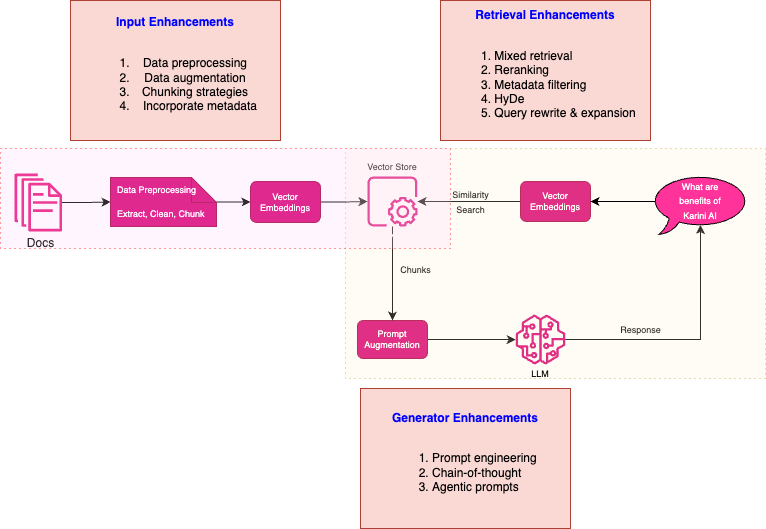When creating a RAG (Retrieval Augmented Generation) system, you infuse a Large Language Model (LLM) with fresh, current knowledge. The goal is to make the LLM's responses to queries more factual and reduce instances that might produce incorrect or "hallucinated '' information.
A RAG system is a sophisticated blend of generative AI's creativity and a search engine's precision. It operates through several critical components working harmoniously to deliver accurate and relevant responses.
Retrieval:
This component acts first, scouring a vast database to find information that matches the query. It uses advanced algorithms to ensure the data it fetches is relevant and current.Augmentation:
This engine weaves the found data into the query following retrieval. This enriched context allows for more informed and precise responses.Generation:
This engine crafts the response with the context now broadened by external data. It relies on a powerful language model to generate answers that are accurate and tailored to the enhanced input.
We can further break down this process into the following stages:
Data Indexing:
The RAG journey begins by creating an index where data is collected and organized. This index is crucial as it guides the retrieval engine to the necessary information.Input Query Processing:
When a user poses a question, the system processes this input, setting the stage for the retrieval engine to begin its search.Search and Ranking:
The engine sifts through the indexed data, ranking the findings based on how closely they match the user's query.Prompt Augmentation:
Next, we weave the top-ranked pieces of information into the initial query. This enriched prompt provides a deeper context for crafting the final response.Response Generation:
With the augmented prompt in hand, the generation engine crafts a well-informed and contextually relevant response.Evaluation:
Regular evaluations compare its effectiveness to other methods and assess any adjustments to ensure the RAG system performs at its best. This step measures the accuracy, reliability, and response time, ensuring the system's quality remains high.
RAG Enhancements:

To enhance the effectiveness and precision of your RAG system, we recommend the following best practices:
Quality of Indexed Data:
The first step in boosting a RAG system's performance is to improve the data it uses. This means carefully selecting and preparing the data before it's added to the system. Remove any duplicates, irrelevant documents, or inaccuracies. Regularly update documents to keep the system current. Clean data leads to more accurate responses from your RAG.Optimize Index Structure:
Adjusting the size of the data chunks your RAG system retrieves is crucial. Finding the perfect balance between too small and too large can significantly impact the relevance and completeness of the information provided. Experimentation and testing are vital to determining the ideal chunk size.Incorporate Metadata:
Adding metadata to your indexed data can drastically improve search relevance and structure. Use metadata like dates for sorting or specific sections in scientific papers to refine search results. Metadata adds a layer of precision atop your standard vector search.Mixed Retrieval Methods:
Combine vector search with keyword search to capture both advantages. This hybrid approach ensures you get semantically relevant results while catching important keywords.ReRank Results:
After retrieving a set of documents, reorder them to highlight the most relevant ones. With Rerank, we can improve your models by re-organizing your results based on certain parameters. There are many re-ranker models and techniques that you can utilize to optimize your search results.Prompt Compression:
Post-process the retrieved contexts by eliminating noise and emphasizing essential information, reducing the overall context length. Techniques such as Selective Context and LLMLingua can prioritize the most relevant elements.Hypothetical Document Embedding (HyDE):
Generate a hypothetical answer to a query and use it to find actual documents with similar content. This innovative approach demonstrates improved retrieval performance across various tasks.Query Rewrite and Expansion:
Before processing a query, have an LLM rewrite it to express the user's intent better, enhancing the match with relevant documents. This step can significantly refine the search process.
By implementing these strategies, businesses can significantly improve the functionality and accuracy of their RAG systems, leading to more effective and efficient outcomes.
Using Karini AI’s purpose-built platform for GenAIOps, you can build production-grade, efficient RAG systems within minutes.
.jpg)
Comments
Post a Comment